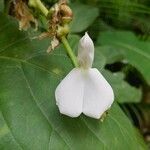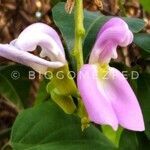Vigorous woody perennial climber with twining stems (grown as an annual in cultivation), up to 10 m long: leaflets ovate or ovate-elliptic, acuminate at the apex, 80-200 x 75-150 mm, sparsely pubescent; petiole (50)145-175 mm long; stipules ± 2 mm long. Peduncles 100-300 mm long, with 8-10 flowers, flowers 25-30 mm long; bracteoles ± 1 mm long. Calyx sparsely pubescent upper lip large, 12-15 mm long, lower lip much smaller, 8-10 mm long. Corolla white; standard broadly obovate, 25-35 x 15-20 mm, claw 3-4 mm long; wings oblong, 14-18 x 4-5 mm, smaller than keel, claw 3-5 mm long; keel obovate, 16-22 x 6-8 mm, claw 3-5 mm long. Ovary narrowly oblong, 8-10 mm long. Pod linear-oblong, very large, slightly compressed, 160-400 (-600) x 35-50 mm, with two longitudinal ribs near the upper suture, 8-16-seeded; seeds very large, oblong-ellipsoid, brick red, with hilum extending most of the upper margin.
Herbs, climbing, several meters tall. Leaflets ovate, 8-20 × 8-12 cm, sparsely whitish or brown pubescent on both surfaces, base rounded or cuneate, apex acuminate. Racemes 10-20-flowered; peduncles 20-25 cm. Flowers 2 or 3 clustered at each node. Calyx 15-16 mm, slightly pubescent, upper lip rounded, lower lip with 3 acute teeth. Corolla white or pink, 3-3.5 cm; petals clawed and auriculate; standard broadly elliptic, 3-3.5 × ca. 2.5 cm, emarginate; wings and keel oblong, incurved, smaller than standard. Legumes linear-oblong, slightly curved, 20-35 × 3.5-6 cm, thickly leathery, each valve with extra rib ca. 5 mm from sutural rib. Seeds reddish brown, elliptic-oblong, ca. 3.5 × 2 cm; hilum ca. 1.5 cm. Fl. Jul-Sep, fr. Oct.
A climbing or sometimes bushy and upright bean plant. Mostly it is a climber. It can be 4 m long. The leaves have 3 large leaflets. The leaflets are oval and 7.5-20 cm long by 5-12 cm wide. The top of the leaf can narrow abruptly to a tip while the base can be rounded or broadly wedge shaped. The leaves are slightly hairy on both surfaces. The leaf stalk is 5-12 cm long. The flowers are in groups and are white. The flower cluster is 7-12 cm long and the flower cluster stalk 4-20 cm long. The individual flower stalks are 2 mm long. The pods are long (20-40 cm) and curved. Seeds are coloured red or pink. The hilum is dark brown and almost as long as the seed.


